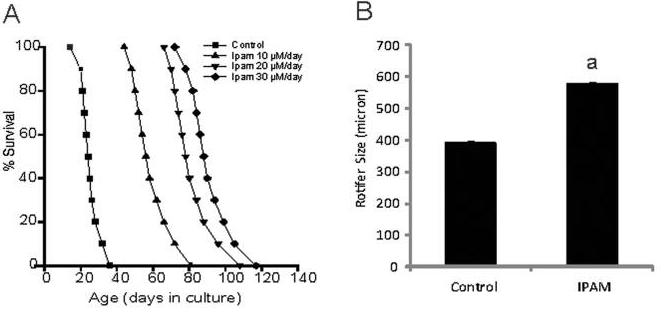IPAMA-
Pharmacology 
IPAM (also known as Indolepropionamide) is a small molecule indole derivative which is similar in structure to melatonin. IPAM is found endogenously in mammals, and serves mainly as a free-radical scavenger. It is a potent lifespan enhancer, but with limited testing.
When studied, IPAM was shown to increase Complex I and Complex IV activity in the mitochondrial electron transport chain [1], however it does not effect Complex II or III. IPAM can also act as a recyclable electron and proton carrier, facilitating reversible endogenous radical and redox reactions, and thereby enabling the formation of a proton gradient that drives mitochondrial ATP synthesis. Thus, IPAM acts as a stabilizer of energy metabolism in mitochondria, thereby reducing the production of reactive oxygen species.
IPAM is a very novel compound, only having one major study to date. It has not yet been tested on rats or other animals, which is unfortunate, however we can still derive a lot from the current study.
IPAM was tested on rotifiers, which are basically millimeter-sized swimming animals, and they are used in early-stage studies for testing. IPAM-treated rotifers (Philodina acuticornis) had a lifespan extended by approximately 300%, the number of offsprings increased by 3.4 times and body length increased by 1.47 times, in comparison with IPAM-untreated rotifers. [1]

Such a lifespan extension in this particular rotifer species is the highest that was ever observed to date in any study, potentially being the most lifespan-enhancing compound ever discovered.
For IPAM's approximate lifespan enhancement in mice, we can calculate using other lifespan enhancers. As an example, rapamycin enhanced 35% longer mean lifespans in rotifiers in a study by Terry W. Snell [4], and on average enhances lifespan in mice by 15-20% averaged accross studies. We can make the approximate (very rough) judgement that IPAM has the potential to enhance lifespan by at least 150% in mice.
Mitochondrial protecting compounds seem to have a higher upside than mTOR modulating compounds which were the previous main target in pharmacology, with compounds like rapamycin.
The authors of the IPAM study also published another study using a similar mitochondrial protector named LPBNAH [2][3]. It seems to have slightly less efficacy than IPAM and has a more complex structure, but it still makes a significant difference. It is unknown whether they can be combined and if that would be effective.
For IPAM's pharmacokinetic profile, it seems to be superior to some similar compounds. IPAM is found endogenously in mammals, so that brings some level of safety to begin with compared to synthetic compounds, and on top of that IPAM has a decent half-life (of about 6-8 hours) [1] and no pro-oxidant activity. In addition, the approximate human dosage is in the milligram range, and considering the compound itself is quite small, it should not be too expensive if used in humans. Saying that, it still only has one study on rotifiers so human usage should be done with caution.
In conclusion, IPAM is a very interesting compound that deserves more attention and research. It is multiple times more effective than other lifespan enhancers and it is the most effective lifespan enhancer in rotifiers to date.
Sources
Related
No related nodes found